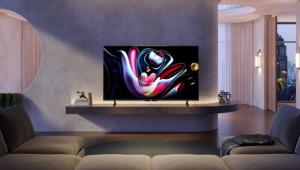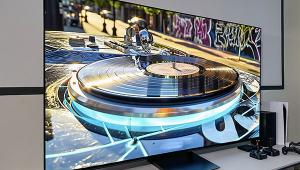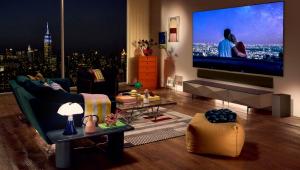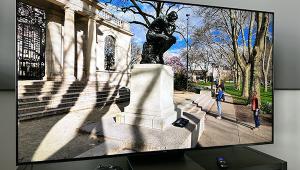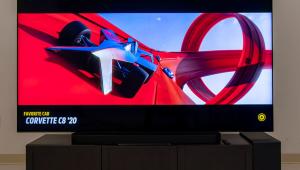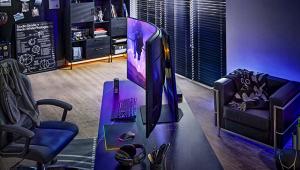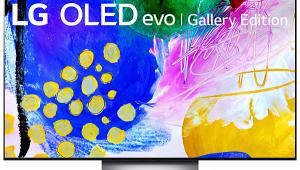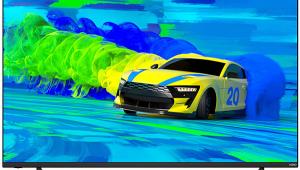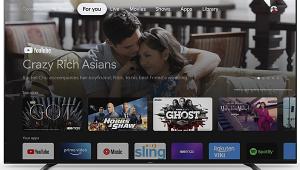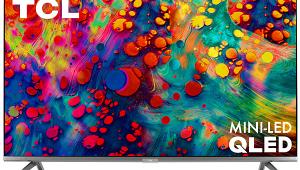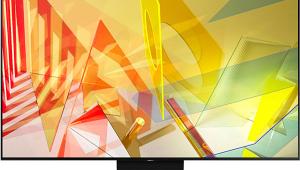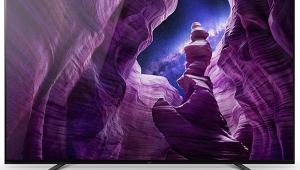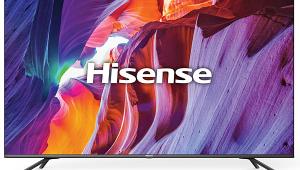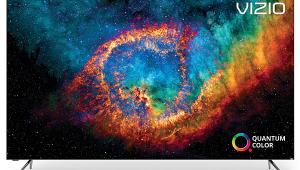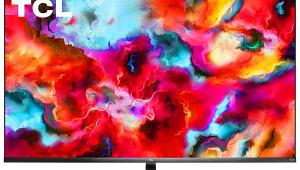LG 65UH8500 LCD Ultra HDTV Review Page 2
 Watching TV
Watching TV
I started with the 1080p Blu-ray of my all-time favorite space movie, the 1995 Ron Howard/Tom Hanks triumph Apollo 13. Despite a bit of soft film grain not commonly seen today, this movie looks and sounds amazing, with tremendous detail, natural color, a nice mix of bright highlights and moody shadows on Earth and in the spacecraft, and (of course) a spectacular DTS-HD Master Audio soundtrack featuring that thunderous Saturn V liftoff. The neutrality of the white shirts worn by NASA personnel, the space suits, and the rocket on its launch pad proved to me that the grayscale was looking good, and the familiar reds and blues of the American flag and NASA logos on the suits came through accurately. And there was more, such as the classic red plaid of an old-style bean-bag ashtray, the gold of the Corvette of Ken Mattingly (Gary Sinise) as the grounded astronaut watches the big launch, and the blue-and-white Earth as seen from space. All looked exemplary and natural.
Details in shadows and dark scenes in the spacecraft were well rendered, something I also noticed while watching a bit of Star Trek—specifically, the 2009 reboot by J. J. Abrams that remains, by far, the best of the three recent Trek features. Early in that movie, when the squid-like Romulan ship is on the attack, all manner of detail was evident in the darker areas near the base of its tentacles. Later, when Captain Pike (Bruce Greenwood) saves the precadet Kirk (Chris Pine) from a bad barroom beating, I could clearly see the shiny, mottled texture and ribbing in his black uniform, while his gold Starfleet badge glistened in the light. Fleshtones looked great and were well delineated, as in a later scene where I could see distinct differences between the red-faced Kirk and the olive-skinned Spock (Zachary Quinto) as they face off in front of a tribunal.
The set’s black level was good for an IPS panel but not great by the standards of today’s higher-end TVs, even the better edge-lit models we’ve seen over the past year. But even in a dark room, it never looked noticeably washed out, and I didn’t feel the need to tinker with the brightness or gamma settings in an effort to extract darker blacks or more shadow detail. I did occasionally play with the LED Local Dimming control, moving it from its default medium setting in the ISF Dark Room mode to the high setting, which gave darker movies a bit more punch, at the sacrifice of some shadow detail. But I was always engaged with the picture.
If anything, I had a bigger issue with backlight artifacts. Wide halos appearing around bright objects on black backgrounds were obvious, though not really distracting. More concerning was light bleed into the black bars above and below a widescreen movie image whenever something bright came on screen near the picture’s top or bottom boundary. It was easy to see where this came from: Introducing something as simple as the remote’s pointer to a fullfield black test pattern would cause the LEDs above and below it to pop on and illuminate not just the pointer but a vertical band of light that ran the full height of the screen. It was never noticeable in the active image area or on fullscreen content, but these blackbar glow bugs could be fairly obvious depending on the scene, and more so when I viewed HDR material. On the other hand, they were made less prominent by even modest amounts of room light.
Speaking of which: With any kind of content, the 65UH8500 always seemed to look very good in a dimly lit or even brightly lit room. Whenever I install a TV for evaluation, it sits a long 18 feet from the desk chair at the back of my studio. During my review period with the LG, as I let the set run idly and silently while I worked, I was struck by how often I would turn my head and be taken in by the vibrant color and the crisp image, even from that distance.
I spent some time looking at 3D discs, including Pixels, Coraline, and a BBC nature documentary. I’m not much of a 3D fan to begin with, and I wasn’t impressed here. The picture was bright and detailed for 3D, but I’m sensitive to ghosting and saw plenty. There are controls to tune out the common parallax errors on individual scenes (as well as an Auto setting), but I never found any combination of them that eliminated ghosting at all focal planes in every scene. Maybe that’s just me.

UHD and HDR
This was my first extended visit with an HDR-compatible Ultra HDTV, and it left me suitably impressed, even with the moderate capabilities of this mid-priced set. You need content that takes advantage of it, and while you can see the brighter highlights and punchier contrast at work in many types of interior and exterior scenes, the benefits of HDR seem to be most dramatic when there’s natural sunlight (or the artificial equivalent) in the scene.
In keeping with my space odyssey, I turned to The Martian on Ultra HD Blu-ray with HDR10. There are lots of scenes where faces and features of the characters and equipment are thrown into sharper relief by bright lighting. But one that really showed off what HDR can do occurs in chapter 15, when the crew of the Hermes is learning via video message that Mark Watney (Matt Damon) is still alive on Mars (no spoiler there). As the astronauts gather around the monitor, which is lit at its base by a bank of LEDs that really pop off the screen, their spinning ship’s windows are moving slowly in and out of the sunlight. At one dramatic moment, a beam briefly crosses over half of the face of Commander Lewis (Jessica Chastain). On the LG, it looked, well, bright, and it came across with enough punch to elicit (for me) a subtle visceral response. At the same time, the details in her face never got blown out or oversaturated, as usually occurs when you try to extract that much brightness from an LCD set. When I watched the same scene in 1080p, it looked good but was clearly less punchy, and it seemed almost lifeless by comparison. Neither the LEDs under the monitor nor the commander’s face imparted that 3D quality. Flipping on the HDR Effect mode did restore a bit of the luster I’d seen in the HDR version, putting some brightness back into the highlights. But the image had less dynamic range overall.
With another Ultra HD Blu-ray, X-Men: Days of Future Past, the HDR was less prominent generally, but it enhanced certain scenes. When Wolverine (Hugh Jackman) returns to the Xavier School to find the younger Professor (James McAvoy), his face is sometimes spotlighted by bright sun streaming in from windows in the vaulted ceiling. Later, when the mutants are about to board a private jet, the sun glistens off the top of the plane as the camera zooms forward, leaving sparkling, specular flashes that I’m certainly not used to seeing from a video display. Nice!
Dolby Vision content is only available via streaming for now. I watched The Legend of Tarzan on a 4K Dolby Vision stream from Vudu to get a good look. (It was a $9.99, 24-hour rental, by the way!) As soon as the blue-and-gold Warner Bros. logo came on, I was taken aback by its brightness and dimensionality. As with X-Men, Tarzan was served sporadically by HDR. In an early scene where Lord Greystoke (Alexander Skarsgård) is being pitched by the British Prime Minister (Jim Broadbent) to travel to the Congo, the bright green tabletop gets spackled by sunlight and takes on an unusually strong, punchy sheen. Later, when he’s sitting on the limb of a tree kissing his wife, Jane (Margot Robbie), her white dress pops out in relief. And in another scene, subdued sun that illuminates the African savanna while the couple hikes across it gives a natural glow to the golden grassland and the shiny coats of a family of lions that recognize Greystoke from his days as Tarzan. I can’t say that Dolby Vision was noticeably more effective than anything I’d seen in HDR10, but it was clearly on par. And it left me even more convinced of what I’ve said in editorials based on demos: HDR is the real deal.
Conclusion
In the end, LG’s 65UH8500 needs to be taken in context. It suffers from the usual issues with deep black and contrast that are indigenous to IPS panels, though perhaps less so than others we’ve seen before. Still, the mere use of an edge-lit, IPS panel probably eliminates this TV from primary display contention for any serious videophile. I acknowledge, as other reviewers have, that there are same-size alternatives near this price or below that will deliver better contrast overall, even some that share this set’s uncommon inclusion of both HDR10 and Dolby Vision compliance (specifically, Vizio’s M series and P series). But they do so with less styling and panache, a different user experience, and a notably more restricted viewing window.
We enthusiasts tend to get obsessed, but the reality is this: Not every TV on the market has to be a videophile’s TV, nor does every TV in a videophile’s home have to be a videophile TV. This LG offers outstanding, striking color and an engaging, punchy picture in most environments, particularly when it’s playing HDR material. For rooms where you tend to watch in modest to bright lighting, or require off-axis seating, it’s a very good choice that will leave you marveling at the picture. Meanwhile, inclusion of the two primary types of HDR will leave you future-proofed. And for a set of this solid build quality and feature content, it comes in at a reasonable price.
LG has made IPS panels and their wide viewing angle an important hallmark of their LCD line, which speaks to how they feel most people live and watch TV. And at this price point, they’re making the most of it in the 65UH8500. If the IPS approach fits for you, it’s an excellent choice.
- Log in or register to post comments

